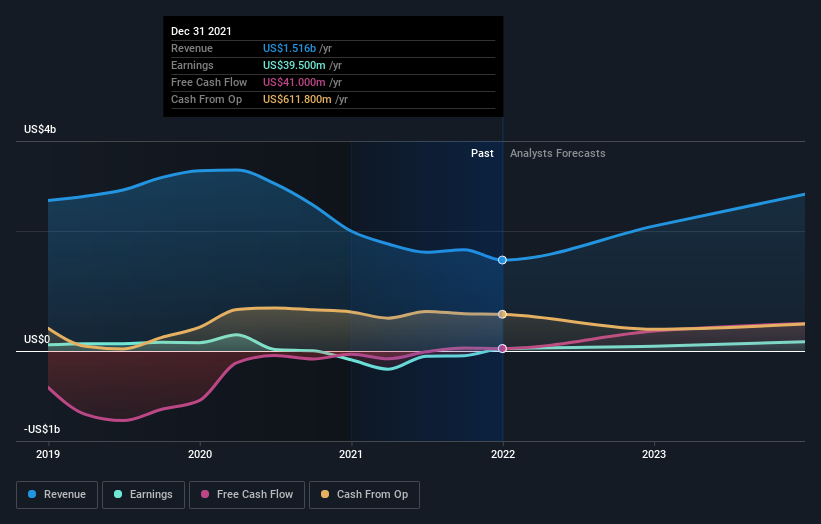The Consensus EPS Estimates For Trinity Industries, Inc. (NYSE:TRN) Just Fell Dramatically
Today is shaping up negative for Trinity Industries, Inc. (NYSE:TRN) shareholders, with the analysts delivering a substantial negative revision to this year's forecasts. Revenue and earnings per share (EPS) forecasts were both revised downwards, with analysts seeing grey clouds on the horizon.
Following the downgrade, the current consensus from Trinity Industries' four analysts is for revenues of US$2.1b in 2022 which - if met - would reflect a huge 37% increase on its sales over the past 12 months. Statutory earnings per share are presumed to surge 140% to US$0.97. Previously, the analysts had been modelling revenues of US$2.4b and earnings per share (EPS) of US$1.20 in 2022. Indeed, we can see that the analysts are a lot more bearish about Trinity Industries' prospects, administering a substantial drop in revenue estimates and slashing their EPS estimates to boot.
View our latest analysis for Trinity Industries
Analysts made no major changes to their price target of US$35.75, suggesting the downgrades are not expected to have a long-term impact on Trinity Industries' valuation. Fixating on a single price target can be unwise though, since the consensus target is effectively the average of analyst price targets. As a result, some investors like to look at the range of estimates to see if there are any diverging opinions on the company's valuation. There are some variant perceptions on Trinity Industries, with the most bullish analyst valuing it at US$38.00 and the most bearish at US$32.00 per share. Still, with such a tight range of estimates, it suggests the analysts have a pretty good idea of what they think the company is worth.
These estimates are interesting, but it can be useful to paint some more broad strokes when seeing how forecasts compare, both to the Trinity Industries' past performance and to peers in the same industry. For example, we noticed that Trinity Industries' rate of growth is expected to accelerate meaningfully, with revenues forecast to exhibit 37% growth to the end of 2022 on an annualised basis. That is well above its historical decline of 13% a year over the past five years. Compare this against analyst estimates for the broader industry, which suggest that (in aggregate) industry revenues are expected to grow 7.4% annually. So it looks like Trinity Industries is expected to grow faster than its competitors, at least for a while.
The Bottom Line
The most important thing to take away is that analysts cut their earnings per share estimates, expecting a clear decline in business conditions. Unfortunately, analysts also downgraded their revenue estimates, although our data indicates revenues are expected to perform better than the wider market. The lack of change in the price target is puzzling in light of the downgrade but, with a serious decline expected this year, we wouldn't be surprised if investors were a bit wary of Trinity Industries.
Even so, the longer term trajectory of the business is much more important for the value creation of shareholders. We have estimates - from multiple Trinity Industries analysts - going out to 2023, and you can see them free on our platform here.
Another way to search for interesting companies that could be reaching an inflection point is to track whether management are buying or selling, with our free list of growing companies that insiders are buying.
Have feedback on this article? Concerned about the content? Get in touch with us directly. Alternatively, email editorial-team (at) simplywallst.com.
This article by Simply Wall St is general in nature. We provide commentary based on historical data and analyst forecasts only using an unbiased methodology and our articles are not intended to be financial advice. It does not constitute a recommendation to buy or sell any stock, and does not take account of your objectives, or your financial situation. We aim to bring you long-term focused analysis driven by fundamental data. Note that our analysis may not factor in the latest price-sensitive company announcements or qualitative material. Simply Wall St has no position in any stocks mentioned.

